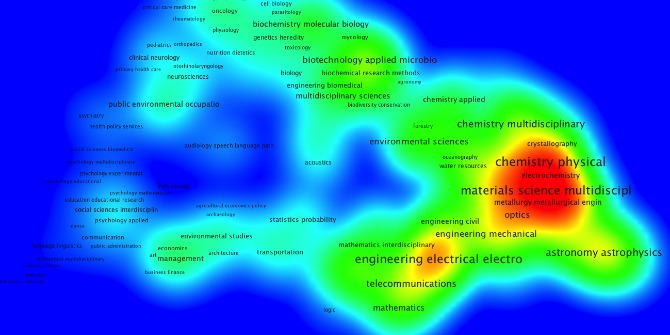
 The number of publishers allowing some form of self-archiving has increased noticeably over the last decade or so. However, new research by Elizabeth Gadd and Denise Troll Covey shows that this increase is outstripped by the proliferation of restrictions that accompany self-archiving policies. In an environment where publishers may in fact be discouraging preferred models of open access, it’s time to redefine what it means to be Green.
The number of publishers allowing some form of self-archiving has increased noticeably over the last decade or so. However, new research by Elizabeth Gadd and Denise Troll Covey shows that this increase is outstripped by the proliferation of restrictions that accompany self-archiving policies. In an environment where publishers may in fact be discouraging preferred models of open access, it’s time to redefine what it means to be Green.
We often find ourselves quoting Goodhart’s Law. Goodhart’s Law states that when a measure becomes a target, it ceases to be a good measure. And of course, most measures become targets in the end, because those being measured want to improve their performance against that measure. This has its most disastrous consequences with things like NHS performance measures. It’s not uncommon to hear of hospitals leaving patients in ambulances outside in order to reduce the load on an overcrowded A&E department at risk of not meeting their four-hour turnaround times. If measures become targets they can drive unintended behaviours. In such cases, we need to change the measures.
We’ve recently observed this phenomenon in our study of publisher open access policy changes over time. It all started innocently enough. The open access movement encouraged the self-archiving of journal papers on the internet. Some publishers allowed this and some didn’t. So the RoMEO project created a listing of publisher open access policies and helpfully colour-coded those policies that allow immediate self-archiving of some version of a work: Green, for those allowing immediate self-archiving of both pre-print and post-print; Blue, for those allowing the post-print; Yellow, for those allowing the pre-print; or White, for those that allowed neither. The list became a database and the database became a service. In 12 years it has grown from 107 publisher policies to over 2,000 and many academics and institutional repository managers rely on it to inform their open access activities.
In that time, many open access advocates have used the statistics supplied by the RoMEO service to encourage the take-up of self-archiving, pointing to the increasing number of publishers who have turned Green or at least allow self-archiving of some sort. However, speak to any academic or institutional repository manager and they will not report a life made easier by the number of publishers warming to self-archiving. An investigation by Research Consulting into the cost of complying with the UK funders’ open access mandates warned that “several institutions participating in [their] project raised the question of whether libraries’ current role in rigorously policing individual deposits to ensure compliance with publisher policies is sustainable as volumes increase”. So what’s going on?
 Image credit: The book and the grass, by torange.biz. This work is licensed under a CC BY 4.0 license.
Image credit: The book and the grass, by torange.biz. This work is licensed under a CC BY 4.0 license.
The problem is that while the number of publishers meeting the criteria for a RoMEO colour code, Green, Blue or Yellow, has increased over time, the number of restrictions on when, where and how papers might be self-archived have increased at an even faster rate. By tracing the policy journey of the original 107 publishers on the RoMEO database, we found that the number of publishers allowing some form of self-archiving grew by 12% in the 12 years since 2004. However, the volume of restrictions around how, where and when self-archiving may take place increased by 119%, 190% and 1,000% respectively. And the rate of growth of paid (Gold) open access offerings from publishers has grown 1,670% in the same time frame. This begs the question: are publishers paying lip service to being RoMEO Green whilst simultaneously making their policies so complex that authors are forced to pay for Gold?
Of course, the version of a paper (pre-print or post-print) that can be self-archived immediately is important. Authors want immediate access to the final, post-refereed version and preferably the publisher PDF. Grading publishers on whether they only allow access to the pre-print or post-print or both has some meaning. However, where the paper can be posted and how the paper can be used are equally important. The Bethesda Definition of Open Access states that open access papers should be put in repositories where they have the best chance of being discovered and preserved for the long term. It also states that papers should be made available under the most liberal of re-use terms. We found that 35% of publishers earned their RoMEO colour by allowing deposit of the pre- or post-print on a personal or institutional web page only; posting on subject or institutional repositories was embargoed or prohibited. And a publisher’s re-use terms are not classified by the RoMEO database in any systematic way.
To test the theory that publishers are in reality discouraging open access as defined at Bethesda and preferred by authors, we took a look at the number of publishers meeting the criteria for RoMEO Green over time and the number meeting the criteria for a ‘redefined green’, namely, allowing immediate deposit of the post-print in an institutional repository. We found that whilst the percentage of RoMEO Green publishers had increased 8% over the 12 years, the percentage meeting the ‘redefined green’ criteria decreased by 35% (Figure 1).
 Figure 1. The trajectory of ‘RoMEO green’ and ‘redefined green’ over time. Source: Gadd and Covey (2016). What does ‘green’ open access mean? Tracking twelve years of changes to journal publisher self-archiving policies, Journal of Librarianship and Information Science. This figure is reproduced here with permission.
Figure 1. The trajectory of ‘RoMEO green’ and ‘redefined green’ over time. Source: Gadd and Covey (2016). What does ‘green’ open access mean? Tracking twelve years of changes to journal publisher self-archiving policies, Journal of Librarianship and Information Science. This figure is reproduced here with permission.
Are we seeing Goodhart’s Law in action? Has the measure (do you allow pre-print, post-print or both?) become the target (being awarded a Green, Blue or Yellow label)? And is the unintended consequence a publisher policy environment that is unbearably complicated and still fails to achieve the sort of open access the scholarly community wants to see? We think so. The measure has become the target. And if we really want to influence publisher behaviour, we need to change the measures. It’s time to redefine what it means to be Green to ensure that only those publishers that fully support community-agreed priorities for open access hit the target.
This blog post is based on the authors’ article, ‘What does ‘green’ open access mean? Tracking twelve years of changes to journal publisher self-archiving policies‘, published in the Journal of Librarianship and Information Science (DOI: 10.1177/0961000616657406).
Note: This blog post was updated after publication to more prominently acknowledge the article on which it is based.
Note: This article gives the views of the author, and not the position of the LSE Impact Blog, nor of the London School of Economics. Please review our comments policy if you have any concerns on posting a comment below.
About the authors
Elizabeth Gadd is the Research Policy Manager (Publications) at Loughborough University. She co-founded the LIS-Bibliometrics forum for those involved in supporting bibliometrics in UK universities, and is the Metrics Special Interest Group Champion for the Association for Research Managers and Administrators. Having worked on a number of research projects, including the JISC-funded RoMEO Project, she is currently studying towards a PhD in the impact of rights ownership on the scholarly activities of universities.
Denise Troll Covey is the Emeritus Scholarly Communications librarian at Carnegie Mellon University, USA. Her research interests include open access, scholarly communication and intellectual property. Her work has been published in portal: Libraries and the Academy, Journal of Digital Information,Progressive Librarian, and tripleC: Communication, Capitalism & Critique.








3 Comments